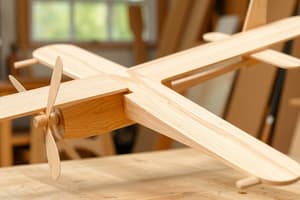Podcast
Questions and Answers
Which property describes a material's ability to resist permanent deformation under a compressive force?
Which property describes a material's ability to resist permanent deformation under a compressive force?
- Plasticity
- Malleability
- Elasticity
- Hardness (correct)
Which property is characterized by a material's ability to deform under tensile stress and be stretched into a wire?
Which property is characterized by a material's ability to deform under tensile stress and be stretched into a wire?
- Malleability
- Plasticity
- Toughness
- Ductility (correct)
Which property is demonstrated when a walnut is bent into the shape of a bench?
Which property is demonstrated when a walnut is bent into the shape of a bench?
- Hardness
- Elasticity (correct)
- Ductility
- Malleability
A polymer splint used for a broken limb exemplifies which property?
A polymer splint used for a broken limb exemplifies which property?
What is a key characteristic of a material that is considered tough?
What is a key characteristic of a material that is considered tough?
Which property is measured by the depth of penetration of an indenter under a load, as in the Rockwell scale?
Which property is measured by the depth of penetration of an indenter under a load, as in the Rockwell scale?
What property allows copper to be used in plumbing due to its ability to stretch into wires?
What property allows copper to be used in plumbing due to its ability to stretch into wires?
Which property describes a material's ability to be flattened into thin sheets by hammering or rolling?
Which property describes a material's ability to be flattened into thin sheets by hammering or rolling?
What is the relationship between electrical resistivity and the flow of electric current?
What is the relationship between electrical resistivity and the flow of electric current?
Which type of stress is defined as 'twisting' force applied to a material?
Which type of stress is defined as 'twisting' force applied to a material?
What does the term 'elasticity' refer to in the context of materials?
What does the term 'elasticity' refer to in the context of materials?
Which type of stress involves forces pressing together on a material from both ends?
Which type of stress involves forces pressing together on a material from both ends?
Which mechanical property of a material is often tested using a Universal Testing Machine?
Which mechanical property of a material is often tested using a Universal Testing Machine?
The ability of a material to withstand loads applied from both ends acting inwards is called?
The ability of a material to withstand loads applied from both ends acting inwards is called?
Which of the following is a property that relates to the material's ability to resist deformation under stress?
Which of the following is a property that relates to the material's ability to resist deformation under stress?
The image of steel girders with built-in expansion room is a demonstration of what?
The image of steel girders with built-in expansion room is a demonstration of what?
Which of the following is NOT a characteristic of a biodegradable material?
Which of the following is NOT a characteristic of a biodegradable material?
Which of the following materials is NOT mentioned as a biodegradable material?
Which of the following materials is NOT mentioned as a biodegradable material?
What is the main challenge presented by the high durability of plastics?
What is the main challenge presented by the high durability of plastics?
What is the role of microorganisms in the process of biodegradation?
What is the role of microorganisms in the process of biodegradation?
Which of the following is NOT a benefit of designing products with biodegradability in mind?
Which of the following is NOT a benefit of designing products with biodegradability in mind?
Flashcards
Durability
Durability
The ability of a product to remain functional with minimal maintenance throughout its lifespan.
Biodegradability
Biodegradability
The capability of organic materials to be broken down by micro-organisms into simpler substances.
Biodegradable Materials
Biodegradable Materials
Materials that decompose rapidly through micro-organisms' action into natural substances.
Examples of Biodegradable Materials
Examples of Biodegradable Materials
Signup and view all the flashcards
Environmental Impact
Environmental Impact
Signup and view all the flashcards
Material Characteristics
Material Characteristics
Signup and view all the flashcards
Conductivity
Conductivity
Signup and view all the flashcards
Electrical Resistivity
Electrical Resistivity
Signup and view all the flashcards
Strength
Strength
Signup and view all the flashcards
Tension
Tension
Signup and view all the flashcards
Compression
Compression
Signup and view all the flashcards
Elasticity
Elasticity
Signup and view all the flashcards
Shear
Shear
Signup and view all the flashcards
Malleability
Malleability
Signup and view all the flashcards
Ductility
Ductility
Signup and view all the flashcards
Hardness
Hardness
Signup and view all the flashcards
Rockwell Scale
Rockwell Scale
Signup and view all the flashcards
Toughness
Toughness
Signup and view all the flashcards
Compressive Stress
Compressive Stress
Signup and view all the flashcards
Study Notes
Performance Characteristics of Materials
- This topic covers the properties of wood, plastics, and metals.
- Key properties include strength, toughness, ductility, malleability, and more.
- Textbook pages 25-31
Learning Outcomes
- Identify material characteristics (wood, plastic, metal)
- Describe characteristics, testing methods, and relevance
- Explain material use based on characteristics
Conductivity (a)
- Electrical resistivity measures a material's opposition to current flow.
- Low resistivity means the material easily allows current flow.
- Resistivity is represented by the Greek letter ρ.
- Examples measured with ring and test rig include thermal conductivity, specific heat capacity, and density of polystyrene foam, pine wood, rubber, stainless steel, aluminum, gold, and copper.
Strength (b)
- Strength of materials (mechanics of materials) studies how solid objects react to stress and strain.
- Types of stresses include tension, compression, torsion, shear, and bending.
- Images show stress types, steel girders with expansion joints, and smart plastics.
Materials Testing for Strength
- Compression: Measuring resistance to inward forces, tested with Ametek.
- Tension: Ability to withstand stretching forces. Tested using a Universal Testing Machine.
- Torsion: Ability to withstand twisting forces.
- Shear: Measuring ability to withstand forces applied at both ends.
Elasticity (c)
- Elasticity is the ability of an object to return to its original shape after stretching or compressing.
- While rubber bands are a good example of elasticity, this property applies to wood, plastics, and metals.
- An example is the steam-bent walnut furniture.
Plasticity (d)
- Plasticity is the ability of material to be shaped or molded.
- Images show examples of thermo-plastic polymers, steel, and timber-ceramic composites.
Malleability (e)
- Malleability is the ability of a substance to deform under pressure.
- Malleable materials can be flattened into thin sheets with hammering or rolling.
- Many metals with high malleability also exhibit high ductility.
- Copper is a good example of a malleable material, useful for plumbing.
Ductility (f)
- Ductility is the ability of a solid material to stretch into a wire under tensile stress.
- Ductility is measured by percent elongation or area reduction from a tensile test.
- Examples in images show how a material stretches.
- Significant elongation is about 5.0% according to Shigley's Mechanical Engineering Design
Hardness (g)
- Hardness measures resistance to plastic deformation (indentation or abrasion).
- Materials like metals are generally harder than plastics or wood.
- Rockwells scale is a hardness scale based on indentation hardness, measuring depth of penetration under load.
Toughness (h)
- Toughness is a material's ability to absorb energy and deform plastically before fracturing.
- It's the amount of energy per unit volume absorbed before rupturing.
- An IZOD impact test rig is shown.
Durability (i)
- Durability is a product's ability to remain functional without excessive maintenance.
- Plastics can be problematic due to their durability leading to worldwide pollution.
- Examples include a chart showing the durability of timber.
Biodegradability (j)
- Biodegradability means organic substances breaking down into simpler substances via microorganism enzymes.
- Complete breakdown yields inorganic molecules like water, carbon dioxide, and methane.
- Examples of biodegradable materials include PLA, PHB, starch, sugar, cellulose.
Biodegradable Materials (additional notes on page 14)
- Biodegradable materials decompose rapidly with microorganisms.
- Examples include food scraps, cotton, wood, and some manufactured products.
- Future products should be designed for recycling using bio-degradable materials.
Studying That Suits You
Use AI to generate personalized quizzes and flashcards to suit your learning preferences.




